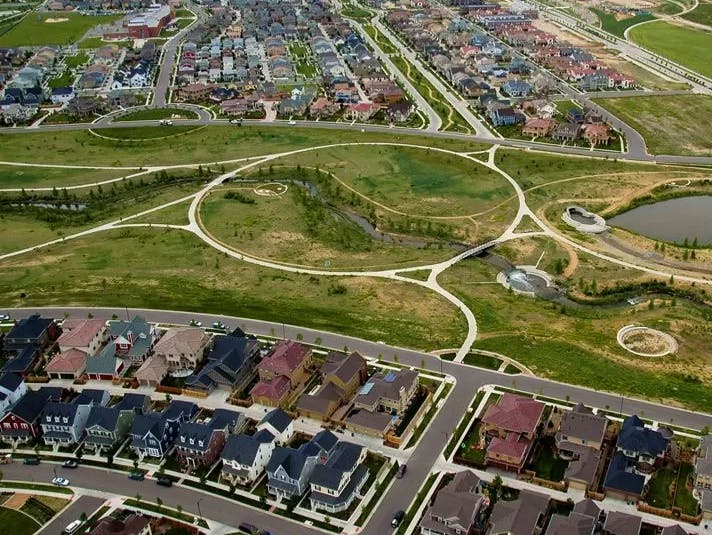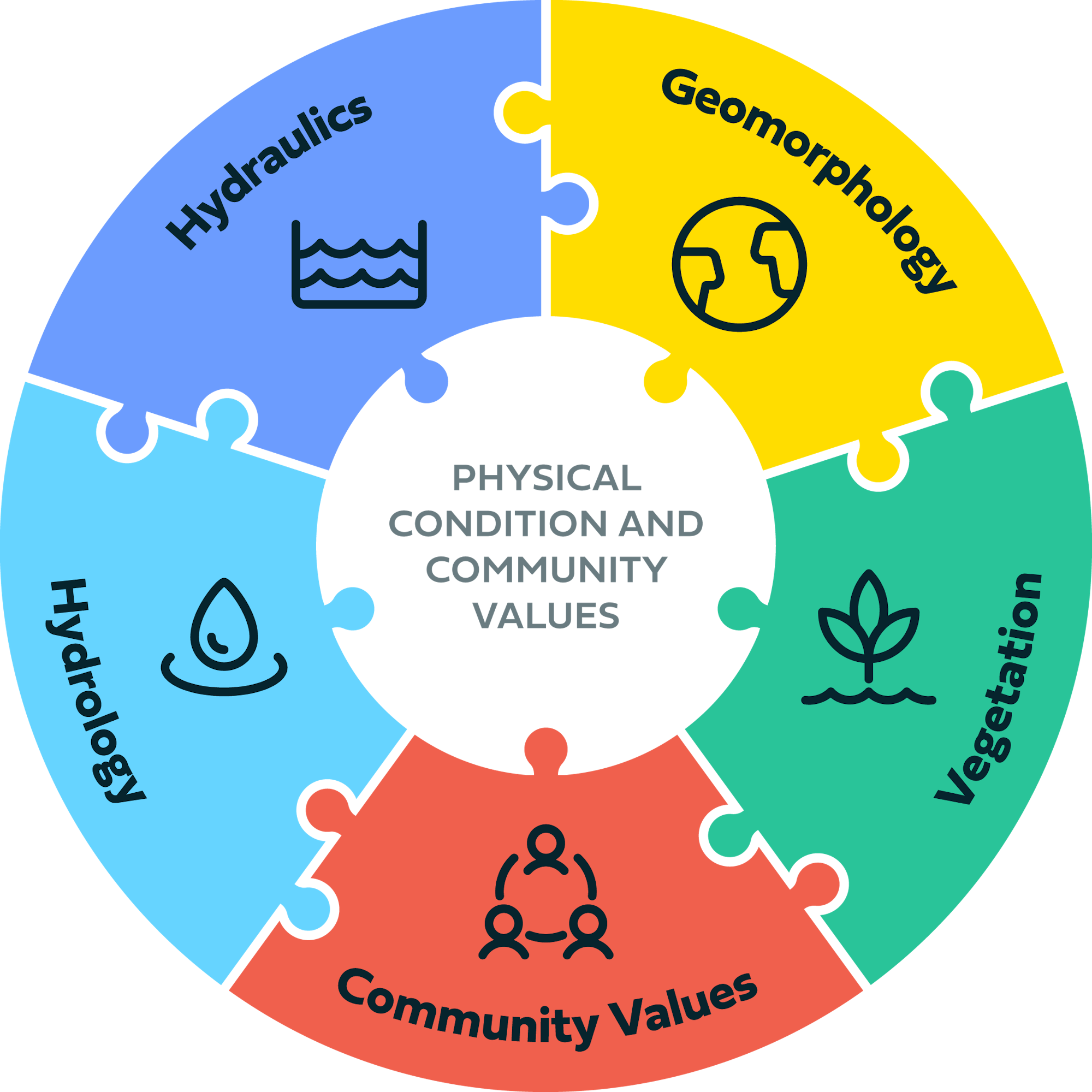The Five Elements of Urban Stream Functions

Promoting Healthy Streams Using the Five Elements
The Five Elements of Urban Stream Function provide a lens for evaluating stream functions and conditions to better inform planning and management of the urban streams in our region. The Five Elements consist of community values, hydrology, hydraulics, geomorphology, and vegetation. While community values address social aspects of streams, hydrology, hydraulics, geomorphology, and vegetation address important physical elements of urban streams. While every MHFD project may not include assessment of all five, all are important in understanding the system as a whole and all should be considered during project chartering.
The Five Elements of Urban Stream Function

Defining The Five Elements

Communities value streams for their strong sense of place in the urban environment, granting waterway managers broad discretion to restore their function. Recognizing community values, including social benefits and concerns, guides the selection of assessment metrics for urban streams. Neglecting these connections may lead to outcomes with little value to people or even to conflicts between community values.
In urban waterway design, MHFD works with communities to prioritize ecological health alongside access and amenities for the community. Identifying community-valued attributes requires an inclusive understanding of diverse community values and in some cases, social science expertise to know how to find those values. In emerging areas without established communities, stakeholders must advocate for future community rights to form meaningful relationships with streams, ensuring compatibility with functioning systems.
.png?ixlib=rb-1.1.0&w=2000&h=2000&fit=max&or=0&s=7dac41636f4b39c1834fe0b64559a316)
Runoff, a key factor influenced by urbanization, significantly impacts hydraulic, geomorphic, and ecological conditions. The Urban Stream Assessment Procedure (USAP) evaluates hydrologic processes crucial for stream resilience, animal and plant life, and human benefits. For example, overbank flows nourish floodplain vegetation, while moderate peak flows aid sediment flushing and channel maintenance, and baseflows provide persistent habitat and recreational opportunities.
Urbanization impacts hydrology differently based on design and pre-development conditions. Peak flows and runoff frequency typically increase due to heightened runoff from impervious surfaces and sewer overflows. Effects on low flows vary; they may decrease from reduced groundwater recharge or increase from leaks and increased water use. Urban streams exhibit variable flow volumes often becoming flashier, though not universally in naturally flashy systems like arid lands.
.png?ixlib=rb-1.1.0&w=2000&h=2000&fit=max&or=0&s=9939fd8e0c64434222d82407a0ff5ffb)
“Hydraulics” encompasses water movement in channels and floodplains, expressed in depths, velocities, and forces, as well as interactions between sediment, water, and wood. Alterations to flows, a result of hydrological processes, affect hydraulic dynamics. Water movement shapes stream geomorphology and vegetation across various spatial and temporal scales. Stream channel size, vegetation distribution, bed and bank stability, and aquatic habitat depend on flow regimes, local geology, and physical features. USAP aids practitioners in understanding these relationships to define flow requirements for urban streams, enabling the definition, assessment, and policy guidance for more functional flow regimes.
.png?ixlib=rb-1.1.0&w=2000&h=2000&fit=max&or=0&s=e83e1a53fb75546aededb745d13ab309)
Urban streams’ characteristics, including location, shape, and form, are shaped by geomorphic processes like erosion, sediment transport, and large wood dynamics. However, these elements can be altered directly through interventions like constructed channels or rock protection, influencing ecosystem functioning and geomorphic hazards. Human development has led to alterations in physical habitat and sediment transport, contributing to the degradation of urban stream systems.
The connection between a stream and its floodplain is vital for riparian vegetation, habitat, and resilience, and this connection is often severed in urban stream systems by impacts related to urban development. USAP addresses this by focusing on key geomorphic processes such as erosion and sedimentation, recognizing their importance in urban stream management. Assessment of physical attributes at various scales helps us understand geomorphologic characteristics, their role in supporting human values, and their sensitivity to degradation or management interventions.
.png?ixlib=rb-1.1.0&w=2000&h=2000&fit=max&or=0&s=c1f9d253f48c453dbdcc553ec363b9c1)
In urban streams with altered hydrology, improving riparian or wetland vegetation may face challenges due to the persistent effects of altered streamflow. Plant communities that originally established under one set of flow conditions may have trouble adapting to the changes in flow regimes resulting from urban development, and predicting the right vegetation type and location for a future development condition can be very challenging. Thus, rethinking our approach to assessing urban streams is crucial for ensuring the long-term health of vegetation in urban stream systems.
Understanding the interactions between vegetation structure, hydrogeomorphic processes, and stream dynamics is essential. Riparian vegetation supports stability, flow resistance, sediment retention, and provides large wood, enhancing structural complexity. Urban streams not only deliver ecological functions but also support social values vital to communities. Therefore, assessing these functions is critical for identifying and implementing management actions to address stressors degrading them.
The Five Elements & Their Functions
The 5 Elements are the foundation of a stable stream network. The chart below illustrates each of the 5 elements - how they function, why they’re important, and the goals of each.
| Community Values | Hydrology | Hydraulics | Geomorphology | Vegetation | |
|---|---|---|---|---|---|
| Function: The function the element performs in urban streams... | Connect | Distribute | Move | Responds | Resistance |
| Stream Importance: This Element is important to the stream because… | Impacts | Flow Regine | Energy | Functionality | Resiliency |
| Societal Importance: This element is important to human society because... | Quality of Life | Impact | Life Cycle Costs | Risk | Habitat |
| Management Goal: This overarching management goal of the Element is... | Enhance | Minimize | Balance | Sustain | Support |
| Assessment Goal: The goal of the urban stream assessment procedure is... | Envision | Assess | Affect | Changes | Integrity |
| HOVER TEXT | Community Values | Hydrology | Hydraulics | Geomorphology | Vegetation |
|---|---|---|---|---|---|
| Function | Integrates experiential, aesthetic, and cultural attributes help create improved life quality characteristics and encourage stewardship of our waterways | Distribution of precipitation on a watershed, a portion of which makes its way to the stream via surface runoff and subsurface inflow after interception, depression storage, infiltration, and associated losses and storage in the land. | Movement of water in streams through channels and floodplains expressed in depths, velocities, and forces of flows and in interactions between sediment and water. | Response of the stream to water and sediment inputs from the watershed, which define the location, shape, and form of the active channel and floodplain within the valley bottom. | Supports stream dynamics and stability, provides flow resistance and filtering, improves infiltration, and creates habitat. |
| Stream Importance | If poorly managed, human activities can adversely impact our natural ecosystems, resulting in less resilient stream systems, poor aesthetics, and unsafe conditions. | The flow regime (peak, volume, duration, frequency, and timing of runoff over the spectrum of rainfall events) directly affects the physical configuration of the stream, riparian vegetation, water availability, water quality, and flood hazards to people and property. | The energy associated with flowing water shapes streams, influences riparian vegetation, and transports sediment. | A stream that reflects a self-sustaining form given its water and sediment inputs facilitates natural stream functions. | The integrity and function of a stream is reflected in its vegetation; healthy vegetation is integral to dynamically resilient stream corridors. |
| Societal Importance | Thoughtful integration of waterways and stormwater infrastructure into the built environment complements inhabited areas and improves quality of life. | Human activities directly influence watershed hydrology; increased urban runoff and other modifications to the flow regime may impact streams negatively, while efforts to minimize changes from natural watershed hydrology reduce impacts. | Favorable hydraulic conditions associated with appropriately dimensioned channels connected to well vegetated floodplain benches help create high functioning, lower maintenance streams. | The geomorphic stability and natural amenities of a stream system can be upset by adverse impacts of human influences thereby increasing the risk of property loss and the need for maintenance. | Well managed stream corridors create healthy stands of riparian and upland vegetation to improve stability, reduce maintenance costs, and provide aesthetic value and natural and human habitat. |
| Management Goal | To provide waterways and stormwater infrastructure that enhances inhabited areas and improves quality of life while performing essential stream functions and flood protection. | To minimize changes in flow regime from natural (undeveloped) watershed conditions. | To convey the full spectrum of flows by balancing energy and channel resistance in a manner that is compatible with stream morphology and protects people, property, and the environment. | To establish a dynamically self-sustaining stream corridor that conveys water and sediment in a predictable manner that is compatible with adjacent land uses. | To provide elastic structural support against erosive forces and improve infiltration and filtering while not impeding flood conveyance. |
| Assessment Goal | Characterizing human impacts on a stream and the stream on human interests while envisioning opportunities for mitigation and enhancements. | Characterizing the existing and future flow regime in streams to assess the degree of change from natural undeveloped conditions and the resulting influence on streams, people, and property. | Understanding how flow depths, velocities, and forces affect stream stability and flood risks to people, property, and the environment. | Understanding the shape and stability of a corridor, its vulnerability to future changes, and its likely trajectory given historical and existing contexts and potential watershed changes. | Evaluating the type, diversity, and health of riparian and upland vegetation along stream corridors as it reflects overall stream integrity and trajectory. |
